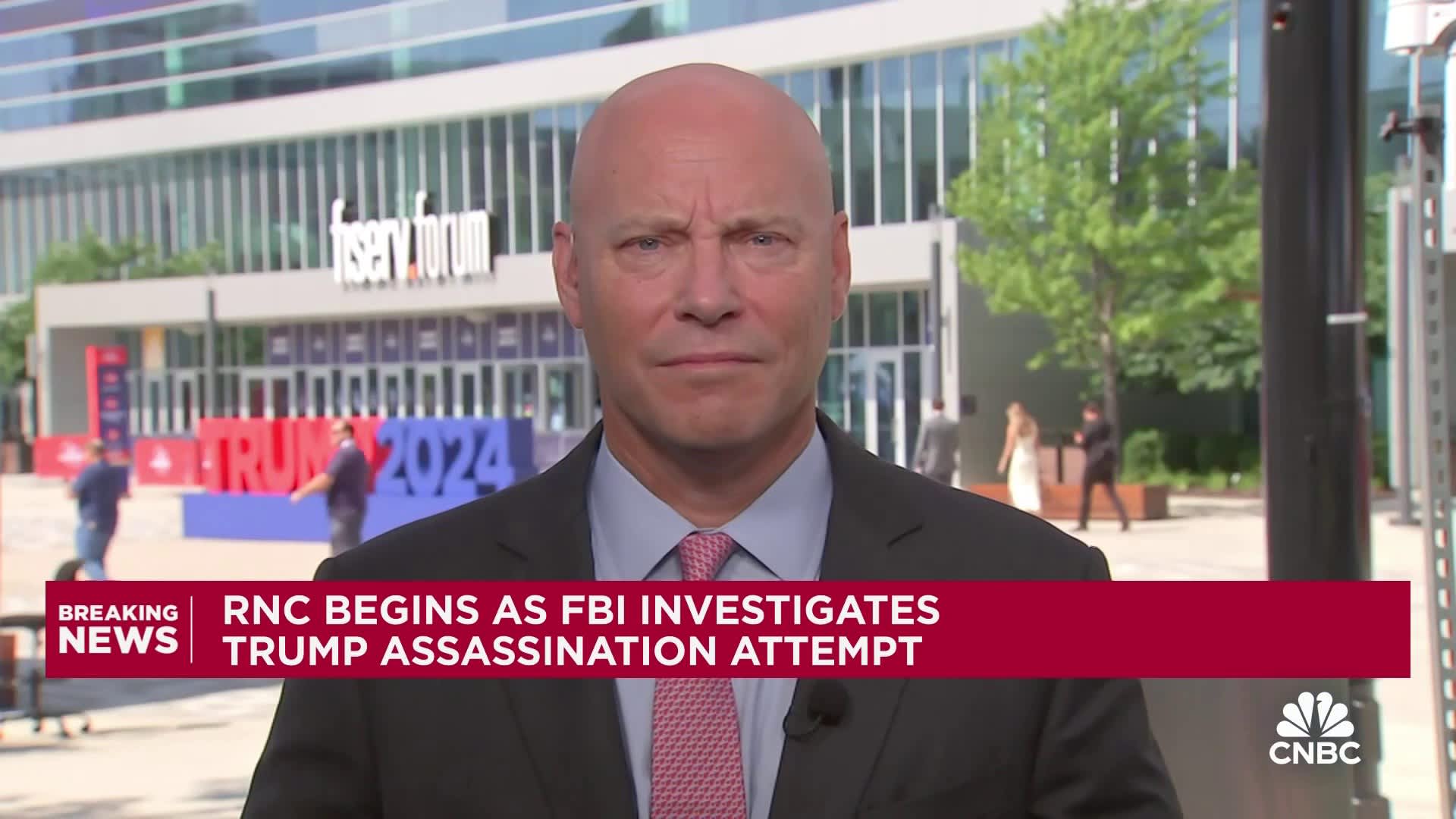Republican presidential nominee and former U.S. President Donald Trump applauds on Day 2 of the Republican National Convention (RNC), at the Fiserv Forum in Milwaukee, Wisconsin, U.S., July 16, 2024.
Elizabeth Frantz | Reuters
As former President Donald Trump secures the Republican presidential nomination, both political parties are eyeing Project 2025, a multi-pronged policy plan created by conservative think tank The Heritage Foundation as a collective effort with more than 100 other right-leaning organizations.
If enacted, the plan could overhaul the U.S. income tax system and revamp the IRS, among other changes.
More from Personal Finance:
Lower capital gains tax, SNAP cuts: What Project 2025 could mean for your wallet
Many Americans think they’re insulated from climate change. Their finances show otherwise
3 money moves to make ahead of the Federal Reserve’s first rate cut in years
The roughly 900-page “Mandate for Leadership” calls for sweeping changes to the federal government and policy recommendations for the next administration. The Heritage Foundation launched the project in 2022 and published the policy collection in April 2023.
President Joe Biden and Democrats have framed the initiative as a preview of a second term from Trump. On a website dedicated to Project 2025, the Biden campaign describes the plan as a “blueprint for Trump.”
Meanwhile, Trump has made statements to distance himself from the mandate.
“I know nothing about Project 2025. I have not seen it, have no idea who is in charge of it, and, unlike our very well received Republican Platform, had nothing to do with it,” Trump wrote on July 11 in a Truth Social post.
However, several former Trump officials have been directly affiliated with Project 2025 and Trump praised the Heritage Foundation in April 2022 in a recently resurfaced video.
“As President Trump said, he has nothing to do with Project 2025,” said Steven Cheung, a spokesman for the Trump campaign. “The only official policy approved by President Trump is the GOP Party Platform found on his website.”
A spokesperson for the Heritage Foundation said the organization was unable to provide a statement. Earlier this month, the group told CNBC: “As we’ve been saying for more than two years now, Project 2025 does not speak for any candidate or campaign. We are a coalition of more than 110 conservative groups advocating policy and personnel recommendations for the next conservative president.”
“But it is ultimately up to that president, who we believe will be President Trump, to decide which recommendations to implement,” the organization said.
Some Project 2025 plans could be enacted via executive action, but many tax policy proposals would require legislation, which could be difficult without Republican control of Congress.
Here’s what the proposed policies could mean for taxes and the IRS.
Reduce the federal tax brackets
Project 2025 aims to “promote prosperity” by reducing marginal tax rates, lowering the cost of capital and broadening the tax base.
The plan departs from the current federal income tax brackets with a “simple two-rate individual tax system” with flat rates of 15% and 30%. The higher tier would start around the Social Security wage base, which is $168,600 for 2024.
For 2024, there are seven brackets with a top rate of 37%. But without action from Congress, some of these rates will increase after 2025 once provisions from the Tax Cuts and Jobs Act, or TCJA, sunset.
Under the Project 2025 proposal, you could pay more or less in federal income taxes, depending on your current bracket, according to Howard Gleckman, senior fellow at the Urban-Brookings Tax Policy Center.
The plan would also eliminate “most deductions, credits and exclusions,” including tax breaks for state and local taxes and education.
However, most Americans don’t claim itemized deductions, Gleckman said. Nearly 90% of filers claimed the standard deduction in 2021, the most recent data available, compared to about 70% in 2017 before the TCJA was enacted, according to IRS data.
The “fundamental reform” outlined in the project could include some type of consumption tax, levied on goods and services, such as a national sales tax, business transfer tax or others.
But these policies could be “quite the battle to get enacted” in Congress, said Garrett Watson, senior policy analyst and modeling manager at the Tax Foundation.
Prasit Photo | Moment | Getty Images
Lower taxes on investment income
The plan also proposes lower taxes on investments for higher earners with capital gains and qualified dividends levied at 15%. Currently, the top rate for long-term capital gains, or assets owned for more than one year, is 20%.
Plus, Project 2025 would abolish the so-called net investment income tax, or NIIT, an extra 3.8% levy on assets for higher earners. The NIIT kicks in once modified adjusted gross income, or MAGI, exceeds $200,000 for single filers or $250,000 for married couples filing together.
Top earners currently pay a combined 23.8% on capital gains including the NIIT, so the proposed tax breaks could be a “big deal” for higher-income investors, Gleckman said.
Reduced estate and gift taxes
Higher estate and gift tax exemptions enacted via the TCJA are scheduled to sunset after 2025. But the plan calls for making the 2017 TCJA changes permanent and reducing the estate and gift tax rate to a maximum of 20%, down from 40%.
Fewer than 1% of taxpayers were subject to estate tax in 2023, according to Tax Policy Center estimates.
“If you’re one of those people, your heirs would be very happy with this proposal,” Gleckman said.
The ‘debate’ over U.S. tariffs
Project 2025 also includes a “debate” on conservative trade policy, including opposing views on tariffs, which are taxes levied on imported goods from another country.
On one side, former White House trade advisor Peter Navarro, who served under Trump, supports U.S. tariffs, including a reciprocal levy, which Trump called for during his 2019 State of the Union address. By contrast, the project notes, Competitive Enterprise Institute president Kent Lassman wrote the U.S. should lower or repeal tariffs to make American goods more affordable.
While Trump says he hasn’t heard of Project 2025, he’s talking about the issue of tariffs a lot, Gleckman said.
Trump has called for a baseline 10% tariff on all U.S. imports and a levy of 60% or higher on Chinese goods. He also floated the idea of an “all tariff policy” to replace federal income taxes in a June meeting with Republican lawmakers.
However, past U.S. tariffs were mostly borne by U.S. companies and consumers, according to a 2020 working paper from economists at the Federal Reserve Bank of New York, Columbia University and Princeton University.
IRS plans could have ‘direct taxpayer impacts’
Project 2025 also proposes changes to “reduce the intrusiveness and increase the accountability” of the IRS.
If enacted, these plans could have “direct taxpayer impacts,” according to Watson.
The agency has faced increased scrutiny from Republicans, particularly after Congress approved nearly $80 billion in IRS funding via the Inflation Reduction Act of 2022.

The plan calls for agency budget cuts — a priority for some Republicans — and, in contrast, at least 20% higher resources for the Office of the Taxpayer Advocate, an independent organization within the IRS.
“Congress should provide the Office of the Taxpayer Advocate with greater resources so that it may better assist taxpayers suffering from wrongful IRS actions,” Project 2025 authors wrote.
There are also proposals to increase the number of presidential appointees, focus on technology and undertake a “serious review” of so-called information reporting, or tax forms sent to the agency by employers and financial institutions.

